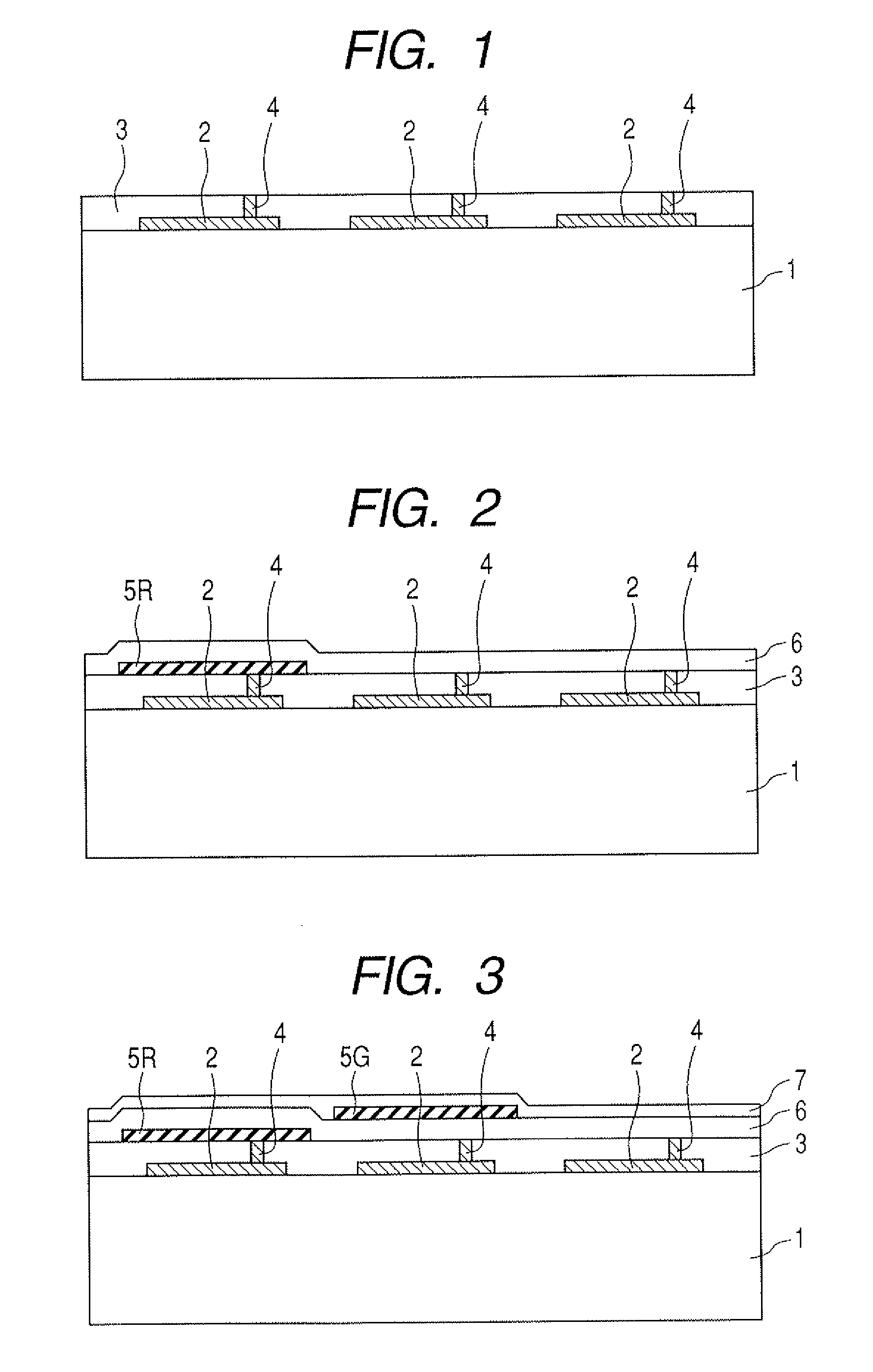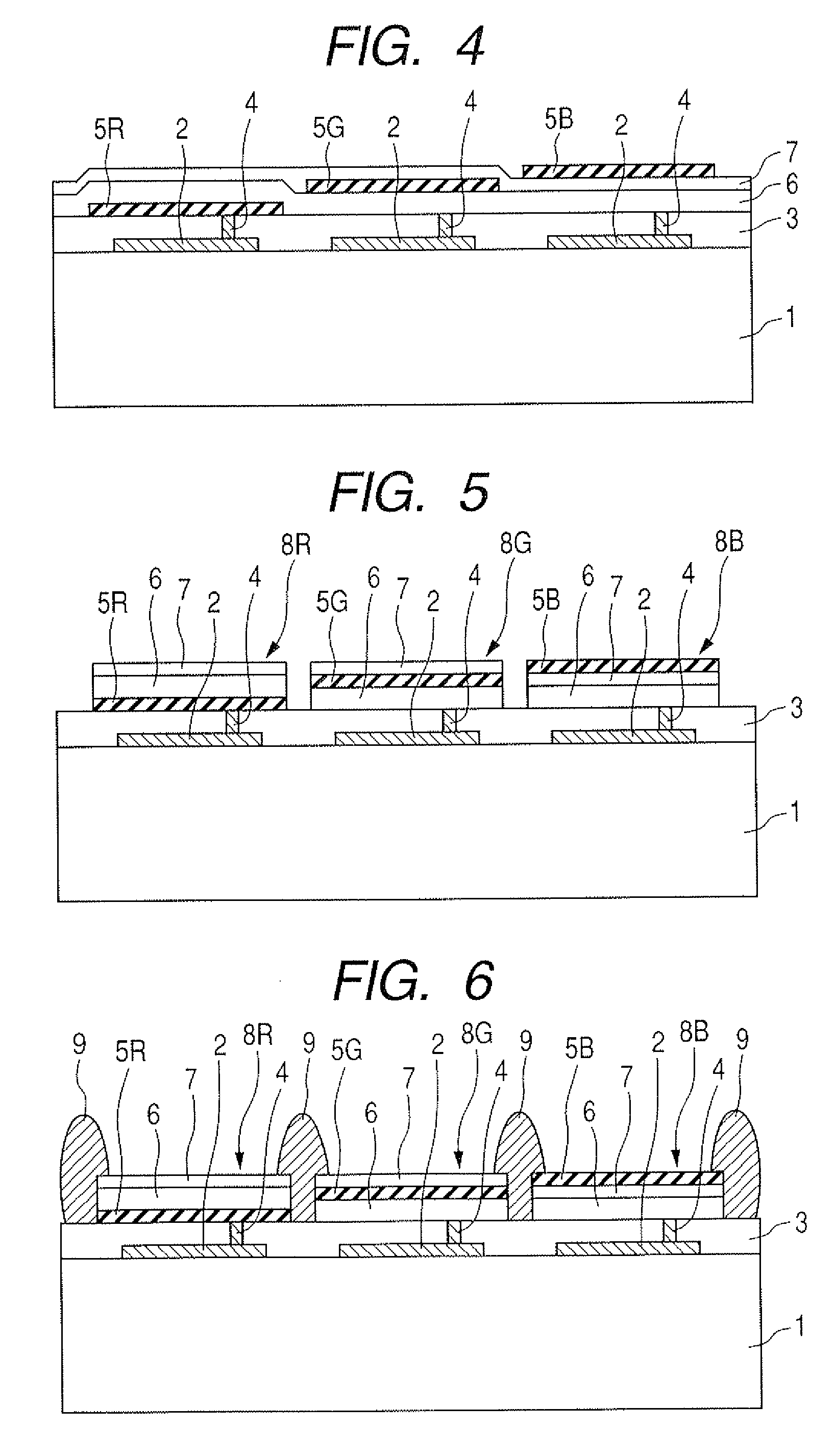Organic light-emitting device and method for producing the same
- Summary
- Abstract
- Description
- Claims
- Application Information
AI Technical Summary
Benefits of technology
Problems solved by technology
Method used
Image
Examples
first embodiment
[0057]FIG. 1 to FIG. 9 are schematically sectional views showing the sequential steps of a process of producing an organic light-emitting device according to a first embodiment of the present invention.
[0058]The organic light-emitting device according to the first embodiment of the present invention has organic light-emitting elements which can emit the lights of three colors (three primary colors) of red, green and blue respectively formed on a substrate. However, such an organic light-emitting device can be also produced in a similar production process to that of the above organic light-emitting device, as is further provided with an organic light-emitting element which can further emit another color like a white color, in addition to the three primary colors of red, green and blue. Each organic light-emitting element in the organic light-emitting device is a top-emission element which emits the light emitted from a light-emitting layer in a direction opposite to the substrate.
[00...
second embodiment
[0101]FIG. 10 is a schematic view showing a diagrammatic structure on the way of a process of producing an organic light-emitting device according to a second embodiment of the present invention. In addition, FIG. 10 relating to the second embodiment corresponds to FIG. 5 relating to a first embodiment.
[0102]As is shown in FIG. 10, the organic light-emitting device according to the second embodiment has an ITO film (third transparent conductive layer 14) stacked on the outermost surfaces (light-extracting side) of the first electrodes 8R, 8G and 8B of organic light-emitting elements for respective colors, which is a different point from the organic light-emitting device according to the first embodiment (see FIG. 5).
[0103]That is, on the reflection layer 5B for a blue light-emitting element in the first embodiment, further a third transparent conductive layer 14 made of vapor-deposited ITO having a thickness of 10 nm is formed to become the first electrode 8B for blue in the present...
third embodiment
[0108]FIG. 11 is a schematic view showing a diagrammatic structure of an organic light-emitting device according to a third embodiment of the present invention. In addition, FIG. 11 relating to the third embodiment corresponds to FIG. 9 relating to a first embodiment.
[0109]As is shown in FIG. 11, the organic light-emitting device according to the third embodiment has a semi-transparent reflection layer 15 provided the lowest surface (opposite side of a light-extracting side) of a second electrode 12 of an organic light-emitting element for each color, which is a different point from an organic light-emitting device according to the first embodiment (see FIG. 9). The semi-transparent reflection layer 15 is made of a conductive material and constitutes the second electrode in the present embodiment. Except the above point, the organic light-emitting device according to the third embodiment has an approximately similar structure to that of the organic light-emitting device according to...
PUM
 Login to View More
Login to View More Abstract
Description
Claims
Application Information
 Login to View More
Login to View More - R&D
- Intellectual Property
- Life Sciences
- Materials
- Tech Scout
- Unparalleled Data Quality
- Higher Quality Content
- 60% Fewer Hallucinations
Browse by: Latest US Patents, China's latest patents, Technical Efficacy Thesaurus, Application Domain, Technology Topic, Popular Technical Reports.
© 2025 PatSnap. All rights reserved.Legal|Privacy policy|Modern Slavery Act Transparency Statement|Sitemap|About US| Contact US: help@patsnap.com



